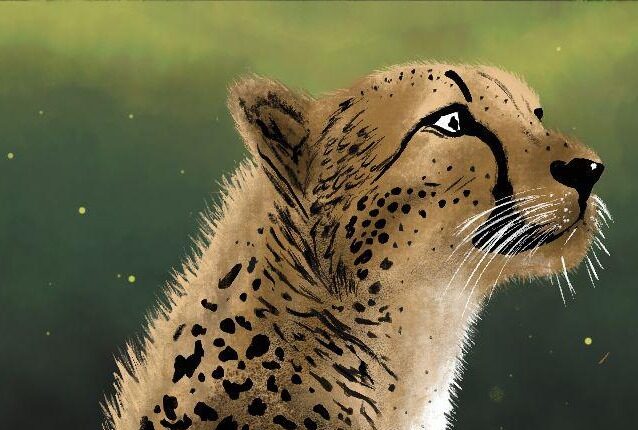The extinct Cheetah is back in India. The Prime Minister released the first lot of wild Cheetah on 17 September 2022, which also happens to be his birthday
 KRC TIMES National Bureau
KRC TIMES National Bureau

The Hon’ble Prime Minister, Narender Modi has yet again set an example!
Now, it is in the field of wildlife conservation. The extinct Cheetah is back in India. The Prime Minister released the first lot of wild Cheetah on 17 September 2022, which also happens to be his birthday.
The ongoing Anthropocene age is marked by our ability to alter the naturescape. Human induced actions are not benign,but are stressors which transform our wilderness. This is a universal phenomenon. A sequel to our landuses and related values, resulting in extinctions of fauna and flora. India is no exception to this.
Almost seventy years back, we lost our Cheetah (Acinonyx jubatusvenaticus). Historically, it was reported across the subcontinent.There is a definite cultural as well as ecological legacy in the context. Many cave paintings, as in the Gandhisagarwildlife sanctuary (Madhya Pradesh) depict the good relative occurrence of Cheetah.
The Cheetah is a dog like cat, adapted for running while chasing its prey. Known popularly as the “hunting leopard”, it wastameable as well. The latter led to royals and shikaris training the animal for hunts. Such practices, along with the lust for shikar, wiped out the Cheetah from our country. Last one was reported in 1947 in Koriya (Chhattisgarh) which was also hunted by the royalty.
Conversations on Cheetah revival did happen. But it became a reality only now. Globally this is unmatched. It has been often cited as the “world’s first transcontinental translocation of an endangered animal”.
Lot of science has gone into this Cheetah initiative. The National Tiger Conservation Authority and Wildlife Institute of India played a major role. An appraisal of suitable release sites within the country was done and an action plan was prepared for the Kuno national park. The protocol for habitat viability including prey density, its carrying capacity for Cheetah, management themes and related aspects were articulated with suitable prescriptions.
A soft release was planned while sourcing the population from Namibia (08) and South Africa (12). The reintroduction happened in “BOMA” (large in-situ enclosures) in a phased manner. The Cheetahs were fitted with radio collars and were monitored regularly using GPS based radio-telemetry.
Each free ranging Cheetah was monitored by a dedicated team of nine persons along with a vehicle. Cheetahs in the wild were regular in making kills. The animals preyed upon were wild species (Spotted Deer, Sambhar Deer, Chousingha, Black Buck, Chinkara, Nilgai, Hare, and Peacock). The kill interval from three free ranging Cheetahs was around 5.6 days. Only a single instance of livestock depredation has been reported.
A year is too short to get insights on Cheetah ethology.
The life history traits of Cheetahs are well documented in the South African context, with many peer reviewed publications. Cheetahs reach sexual maturity around two years of age. The gestation, as typical of felids, is around ninety days with a litter size ranging from two to four cubs. The new born is blind, dependent on its mother for a few months after its birth. The species is solitary in nature but for a brief association during courtship. However, at times, males do form coalitions.
The post-natal care is done by the mother alone. The diet ranges from small to medium size mammals, usually gregarious, viz. Chital, Chinkara, Black Buck, Sambhar, and Nilgai. In South Africa, the prey comprises of gazelles, antelopes, and impalas. At times Cheetah also prey on birds, reptiles and rodents.
The Cheetah is not an apex predator. It is preyed upon by other species like lion, leopard, and hyena.
In the wild, the life span ranges from ten to twelve years. In nature, Cheetahs face lot many threats like habitat loss, poaching, and conflicts with human beings.
The forays made by free ranging Cheetahs are interesting.
A coalition of two males moved around 184 to 266 km. during a period of 101 days, with a home range of 29 to 172 sq.km. A solitary male moved between 29 to 487 km., covering an average daily distance ranging between 4.1 to 6.8 km., with a home range of 61 to 2087 sq.km. A solitary female, during a span of 140 days, moved between 7 to 940 km. with an average daily distance of 0.9 to 6.7 km., making a home range from 1 to 5081 sq.km.
The movement pattern of Cheetah in Namibia and South Africa has been well documented. There is considerable variation in ranging patterns. The home range size of resident male Cheetahs vary from 12 to 350 sq.km. However, floaters move across larger areas ranging between 125 to 1400 sq.km. The ranges of females also show variation from 25 to 600 sq.km. empirical evidences indicate that males move between 1300 to 2200 in farmlands. The core size of male usually is around 20 to 70 sq.km. while its ranges from 30 to 60 sq.km. in females. Home range overlaps are not uncommon in both sexes.
The Cheetah is a coarser and its hunting strategy largely comprises of initial stalking and bringing down the prey through a targeted chase. Given the heterogenous habitat of Kuno with scrubland and woodlots, the Cheetah would adapt for both stalking as well as chasing its prey, while avoiding niche clash with the leopard. This necessitates availability of gregarious ungulates in the habitat with a high relative abundance, in view of the leopard being sympatric in the area.
Kuno is a site within Northern hemisphere. Both Namibia as well as South Africa being in Southern hemisphere have their own climatic regimes. The circadian rhythms of animals adjust accordingly. Since translocation, mortality (seven adults and three cubs) has been reported owing to several causes. Quite a few (three) succumbed on account of septicemic conditions. The latter is attributable to water accumulation in furry dorsal side of such animals (winter pelage timing of South Africa/Namibia at variance with Kuno monsoon). As of now, thirteen adult Cheetahs are surviving.Apart from a cub of last year, two litters have also been reported recently taking the total tally to twenty one.
The Cheetah, as a courser, is a surrogate indicator of open grasslands and their wild denizens. Sustainable Cheetah coalition the long run indicates the well-being of grassland ecosystem. Bringing the Cheetah back gives lot of hope to revival of such ecosystems. A centrifugal landscape approach has been envisioned, involving parcels of land beyond the protected area of Kuno has been envisioned for multistakeholder engagement. Such a landscape approach would involve engagement with multi-stakeholders through mutually gainful agreed actions, with a focus on Cheetah.
The Gandhisagar wildlife sanctuary of Madhya Pradesh has been identified as the second home for Cheetahs. This is an excellent habitat which may be a competing destination for any savanna land of East Africa
The Cheetah reintroduction effort is ecologically significant and timely. With more than five decades of tiger experience, India is well poised in the context for managing the species as a surrogate, multidimensional indicator of biodiversity and human well-being through a landscape approach.
Promotional | NE India Writing Star Contest







